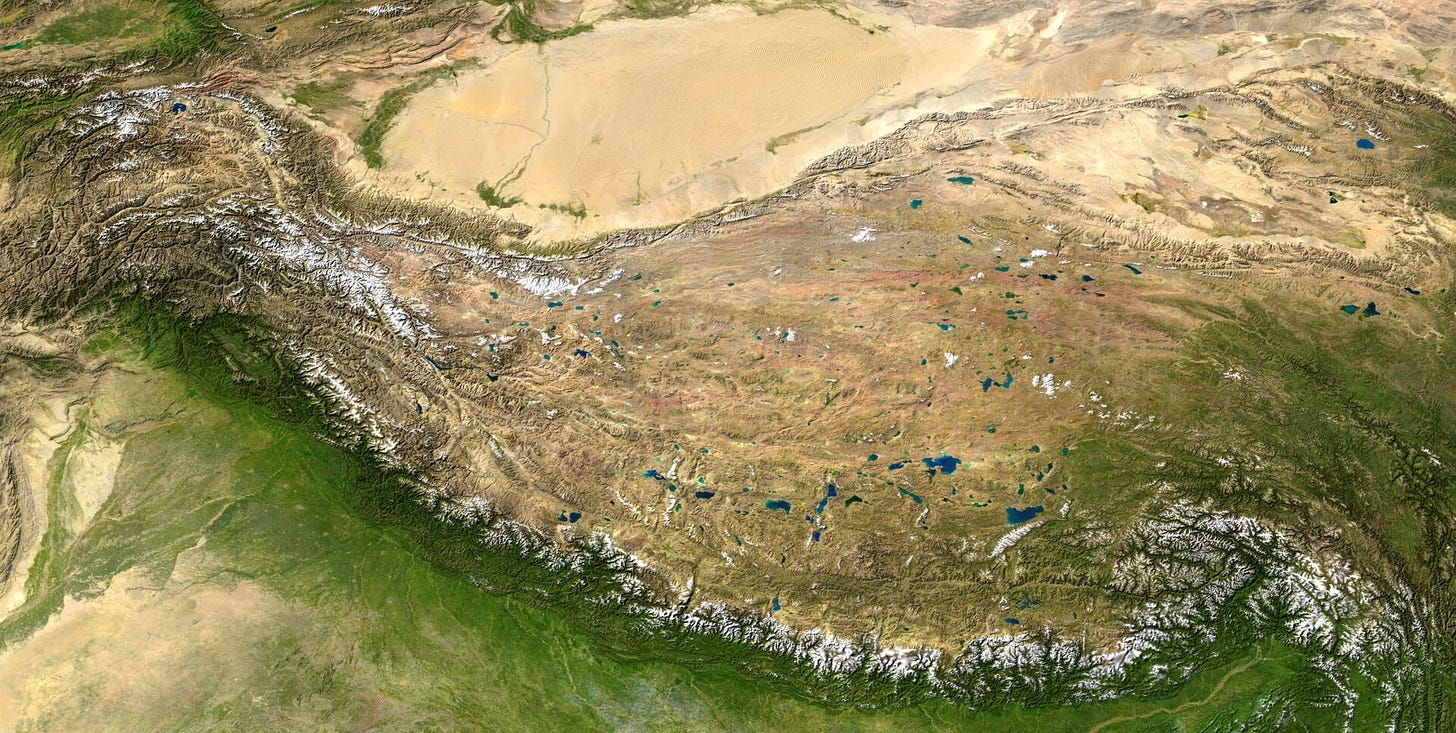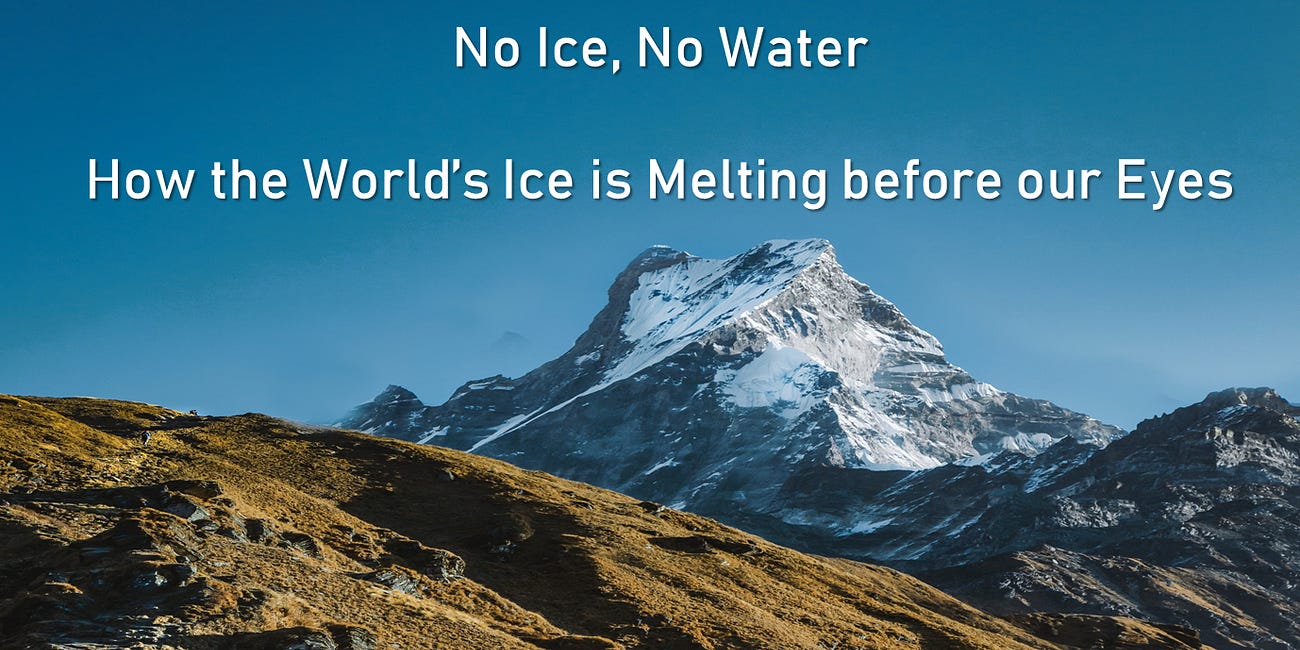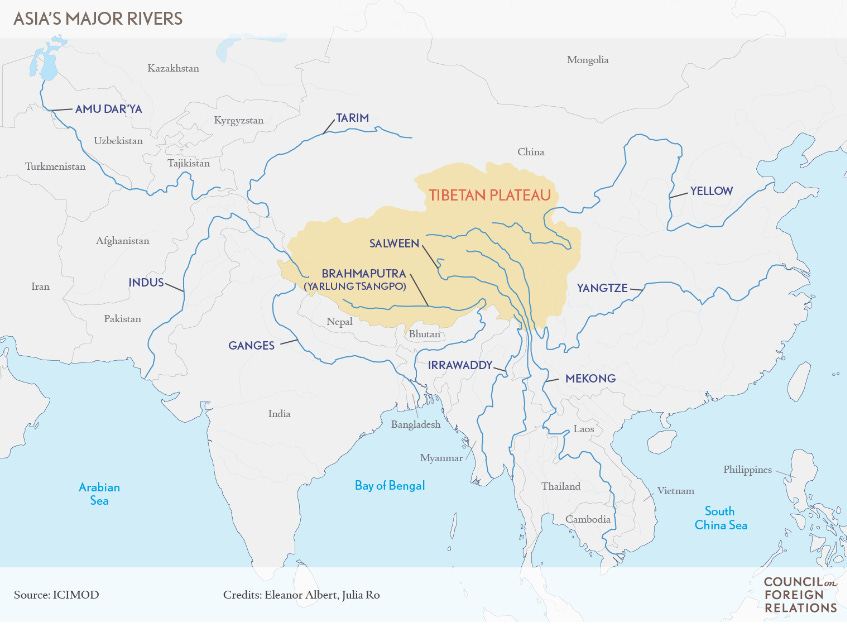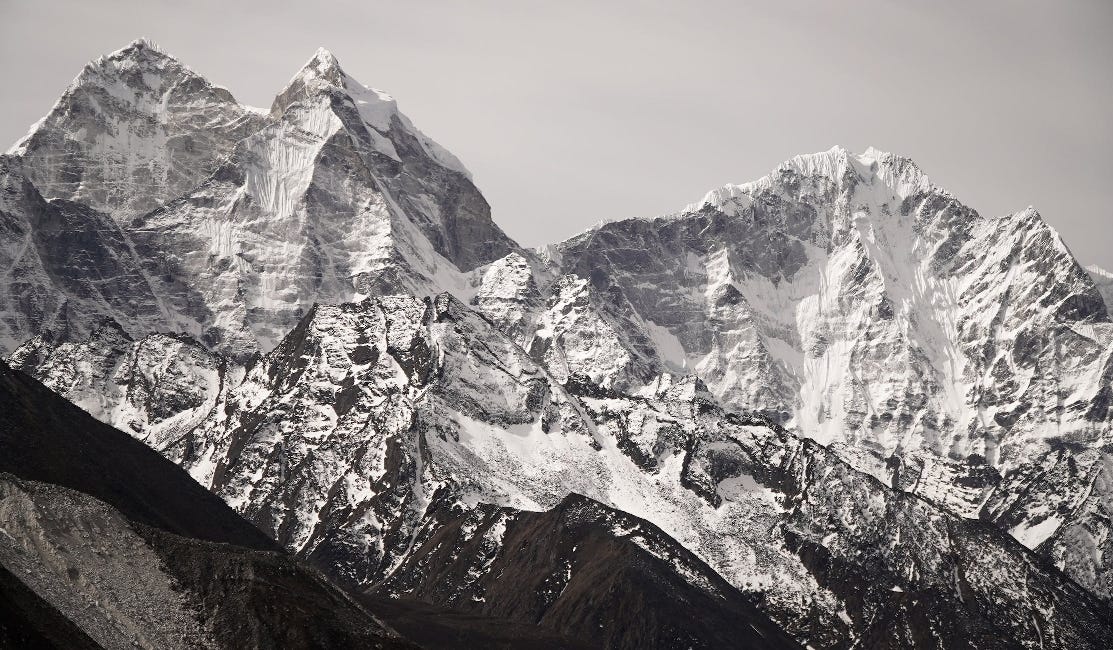Visit the new Evidence Files on Medium, or check out the Evidence Files Facebook; Like, Follow, Subscribe or Share!
Find more about me on Instagram, Facebook, LinkedIn, or Mastodon. Or visit my EALS Global Foundation’s webpage page here. If you enjoy my work, consider becoming a paid subscriber. Thanks!
The Tibetan Plateau
The Tibetan Plateau (hereafter, “TP”) is an interesting place to analyze the effects of climate change because it is unique among landmasses across the globe. More than half of the land sits above 4000 m (13,123 feet), and in total it comprises roughly 2.5 million square kilometers of area (966,000 square miles).
Much of the region is bordered by mountain ranges—in the north by the Kunlun and Qilian Mountains, in the south and southwest by the Himalayas and Karakoram Range, and the Daxue Mountains in the east. Extraordinarily important rivers emerge from the Tibetan highlands, including the Indus, Brahmaputra, Yangtze, Yellow, Mekong, Salween, and the Tarim. These rivers supply freshwater to almost half of the global population.
A composite image of the Tibetan Plateau; Public Domain
The ice melt from various parts of the TP are critical to the health of many major rivers. Among the world’s deposits of ice mass, the TP contains the third largest by volume. This includes the glaciers of much of the Hindu Kush Himalayas. Unfortunately, this entire ice mass is in danger. As noted in “Climate Change Effect on Natural Disasters in Nepal,”
Accelerated warming has had an acute effect on the state of Himalayan glaciers. Between 1970 and 2000, 9 percent of the ice disappeared, and between 2003 and 2009, 174 gigatons of water were lost each year. That number is near impossible to visualize—it is 174 billion tons. Put another way, if this amount were distributed to every man, woman and child in India, each person would receive around 123 gallons of water each year. One study published in 2021 found that contemporary loss of glacier mass in East Nepal and Bhutan has accelerated ten-fold compared to any long-term assessment of previous fluctuations since the Little Ice Age.
Disappearance of Himalayan ice presages an impending water crisis of epic proportions. In “No Ice, No Water,” the extent of the upheaval caused by the loss of Himalayan ice alone is extraordinary:
The Himalayas feed water to regions spanning from Afghanistan to as far east as Myanmar (f.k.a. Burma). Scientists say that the ice melt in the region has occurred faster than any other place on Earth over the same time. Even the most stable glacial area in the region to date—the Karakoram range in Pakistan—has since begun eroding despite ice-mass gains in previous decades. At its current rate of melt, and assuming the world does little to curtail its contribution to causal factors of global warming, as much as two-thirds of the remaining glaciation in the Himalayas will probably disappear.
Reducing the availability of fresh drinking water to such a large number of people will lead to unimaginable consequences. This is especially so as much of that region already faces near unlivable conditions due to rapidly rising temperatures year-upon-year. As drinking water disappears, food production will also decline. Farming in the Himalayan region… depends on these annual cycles for survival. For some areas, snow-melt runoff comprises as much as 72% of total water requirements to cultivate crops, particularly in the upper Indus area. As temperatures heat up annual snow melt decreases, and both exponentially contribute to droughts that only further exacerbate the overall problem.
When combined with water supplied exclusively from the TP, however, the impact is even farther reaching. In China alone, “23% of the population lives in the western regions, where glacial melt provides the principal dry season water source.” Bangladesh, Pakistan, and Uzbekistan have 91.4 percent, 77.7 percent, and 80 percent dependency ratios on waterways fed by this system. The image below shows the reach of Tibetan-supplied rivers.
In addition to the potential for water-based emergencies for the huge number of people dependent upon the hydrological cycle of ice melt and refreeze in the region, the rapid deteriorations of the glacial structure is contributing to rising surface temperatures. The TP affects global climate due in part to its massive size, but with acute consequences for the adjacent region.
In particular, the TP influences subtropical rains in east and southeast Asia, and also exacerbates extreme weather there. Warming of the TP enhances “the formation of freezing rain and heavy snow over central southern China.” These effects are most severe along the downward flow of river waters from the higher regions.
As has been happening more regularly in Nepal, warming creates damaging storms in traditionally cold areas by converting steady, manageable snowfalls into intense hail and heavy, wet snow storms against which infrastructure is less resistant. In normally warmer areas, routine rain cycles give way to bouts of extremely heavy rain followed by longer dry spells. This leads to flash flooding, but can also diminish soil health due to its inability to absorb sudden influxes of substantial rain.
Moreover, runoff from these storms tends to remove some fertilizing minerals, rendering the soil even less fertile. Elevated temperatures also increase atmospheric heating in the region because the reduction of snow-cover lowers the amount of heat reflected away from the surface. This creates greater frequencies of heat waves and droughts, often in between devastating flooding.
High elevation lakes further contribute to this process as their winter freeze rates continue to reduce year-upon-year. Water beneath the thinner ice warms more easily and rapidly, which increases the atmospheric temperature above them and, combined, quickens the pace of annual spring melts. This leads to earlier ‘spring’ seasons, and disrupts the usual hydrological cycle causing water shortages for drinking and agriculture. As the TP contains thousands of these kinds of alpine lakes, the cumulative effect is even more pronounced.
Aside from the environmental effects of global climate change upon the TP, specific geophysical destruction is only worsening the situation. In its quest to “becoming Asia’s upstream water controller,” China has begun or completed construction of numerous significant water diversion projects on TP-fed rivers, which have had enormously destructive effects on the surrounding and downstream environments.
Damming of the Mekong, for example, resulted in a net loss of 126.44 meters of river height over 28 years of measurements for those downstream, leading to frequent droughts and crop shortages. In areas around the dams themselves, residents frequently face flooding of arable land, or full-scale displacement as their homelands become part of massive reservoirs.
Experts argue that these enormous diversion projects on the river systems are negatively affecting the quality and volume of freshwater for almost a billion non-Chinese who rely upon them. This is because many—if not most—of these projects commence without “comprehensive environmental and social impact assessments.” Dam designers and builders often outright refuse to share data necessary to conduct these assessments.
Manmade dams pose obvious threats, but so too do natural ones. Thousands of glacial lakes across the globe have existed for millennia. Rising global temperatures have had two effects related to them. One is the accelerated growth of newly formed lakes. As ice melts, it flows into natural bowls where it sits atop older, thicker ice. The second, and more pernicious, effect is that the ice containing these lakes continues melting itself, thereby destabilizing the overall structure and ability to contain the water within.
The International Centre for Integrated Mountain Development (ICIMOD) has identified 47 glacial lakes in the Himalayas (specifically in Nepal) that pose a substantial threat to lower-lying populations. This evaluation is based upon the weakening of portions of the natural barriers forming the edges of these lakes. When those barriers fail, scientists call what occurs a Glacial Lake Outburst Flood (GLOF). Since 2003, four GLOF events have occurred that killed some people and caused significant damage. Of the 47 lakes identified as dangerous, tens of thousands of people live within the area that would face flash flooding should they give way.
Map of glacial warming areas in Nepal. The red circles, and especially larger red circles, indicate areas of enhanced glacial melt that pose elevated risks for creating GLOF and other related events. Source: Lee, Ethan et. al. “Accelerated Mass Loss of Himalayan Glaciers since the Little Ice Age,” Scientific Reports. Vol. 11, Art 24284
Studying Climate Change in Tibet
Back in 2013, George Schaller wrote the following about his efforts in studying wildlife in the TP:
In November 2011, China’s State Council approved a far-sighted, community-based program of ecological protection for the Sanjiangyuan region. My colleagues and I are now focusing our research and planning on Sanjiangyuan, contributing to the efforts of the provincial and national governments. Based on the awareness that their livelihoods depend on a healthy rangeland, a number of communities have set aside land for wildlife, are checking the condition of pastures, patrolling their land against intrusion by outsiders, and monitoring wildlife numbers and water levels in lakes and streams.
Sanjiangyuan (三江源) means “Three Rivers’ Source” in Chinese. A national park in its name was formed in 2020, which incorporated previously established nature reserves.
Ting Ma, Brent Swallow, J. Marc Foggin, Linsheng Zhong, and Weiguo Sang conducted a comprehensive study of the effects of the establishment of the conservation strategy on local peoples. In 2005, stakeholders created a program called the “one village, one post” project. This emerged from local herding communities who long before receiving any official designation began their own wildlife monitoring programs.
The authors note that the “workforce” of Sanjiangyuan National Park, comprise local residents and ranchers who “serve as environmental and wildlife monitors but also as protectors who detect infractions and serve as liaisons between the National Park and the wider communities of which they are a part.” Localized administration gives residents confidence in their ability to enhance the well-being of both the environment and their lives. Instead of merely being subject to the whims of centralized governance, often from afar, local residents have control over the methodologies of conservation, enabling them to ensure success of the program through the use of traditional practices that succeeded in sustaining them without severely depleting resources for millennia.
While this is not a perfect system, given that it creates a feeling of exclusivity for those living near but outside the boundaries of the park and managed areas, the net effect has been an improvement in both the living standards for many and the general environmental health of the area.
In a separate paper, J. Marc Foggin outlined the way many nomadic peoples within the Tibetan interior have implemented their own practices of measuring the impact of climate change and the efficacy of their responses to it. This has led to an emerging “citizen science,” which has increased collaboration among residents and formally trained scientists of various disciplines.
In total, between officially designated national parks and less-official areas overseen by local farmers and nomads, near one-quarter of China’s overall territory falls under this rubric of conservation led by people who have successfully lived off the land working in direct coordination with experts across a diversity of fields.
Other programs that focus upon the TP have found robust support from the Chinese government and scientists from across the globe. These include analyzing and protecting migratory birds, researching the spatiotemporal patterns and driving factors of vegetation, tracking changes in the soil microbial community, and monitoring the size and health of waterways and snow and ice flows, among many others. These analyses arise from the well-understood fact that the Himalayas, and the TP specifically, provide a harbinger for ecological shifts resultant from climate change coming to the rest of the world. As such, continuing support for this sort of work is critical to the health of the TP as well as to people there and everywhere else.
Final Word
Stakeholder participation will become critical in future responses to climate change issues. This has already proven effective in many places, as illustrated above. I wrote about another example taking place on the Nepal side of the Himalayas here. While what is happening in the TP is promising, the victories in certain places are offset by stunning defeats driven by political economics. The erection of numerous dams built quickly but without sufficient circumspection are just one example.
There remains an enormous tension between economic and conservation interests, but turning over control to local preservationists significantly helps bridge that gap as they have an interest in managing both. Unfortunately, many places in the world facing tipping points on certain environmental problems also suffer from especially contentious politics that go beyond simple economic considerations. For decades, the camp prioritizing politics and economics have been winning the fight, but as more places become difficult or impossible to live in, this will inevitably change. The question by then will only be whether it is too late.
***Scroll to the bottom for an announcement!
To read about another conservation project taking place across several countries in the Hindu Kush Himalaya region, click below.
Announcement:
བོད་ཡིག་སློབ་སྦྱོང་བྱེད་པ།
Are you interested in learning to read the Tibetan language? Or wish to know more about the history or environment in Tibet, Nepal, or the surrounding areas? Visit the Dharma Farm School of Buddhist Translation & Philosophy website here or Facebook here; summer classes are posted, including mine! Or, click on the video to hear about my role there as the newest faculty member!
***
I am a Certified Forensic Computer Examiner, Certified Crime Analyst, Certified Fraud Examiner, and Certified Financial Crimes Investigator with a Juris Doctor and a Master’s degree in history. I spent 10 years working in the New York State Division of Criminal Justice as Senior Analyst and Investigator. I was a firefighter before I joined law enforcement.
Today I work both in the United States and Nepal, and I currently run a non-profit that uses mobile applications and other technologies to create Early Alert Systems for natural disasters for people living in remote or poor areas. In addition, I teach Tibetan history and culture, and courses on the environmental issues of the Himalayas both in Nepal and on the Tibetan plateau. For detailed analyses on law and politics involving the United States, head over to my Medium page.








